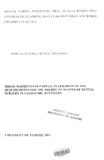| dc.contributor.author | Musera, Dorcas K | |
| dc.date.accessioned | 2013-05-23T10:01:24Z | |
| dc.date.available | 2013-05-23T10:01:24Z | |
| dc.date.issued | 2003 | |
| dc.identifier.citation | Master of Dental Surgery in Paediatric Dentistry, University of Nairobi, 2003 | en |
| dc.identifier.uri | http://erepository.uonbi.ac.ke:8080/xmlui/handle/11295/24798 | |
| dc.description.abstract | Introduction: The need for epidemiological studies on oral diseases will give recent
disease trends especially with comparison of a rural and urban setting.
Objective: To assess the prevalence of dental caries and gingivitis in 10-12-year-old
rural and urban children in Kenya. To determine the oral health knowledge and practices
of the children in both populations.
Design: Cross sectional comparative study.
Setting: Nairobi for urban and Meru South District for rural.
Subjects and methods: Two hundred and forty four children aged 10-] 2 years from 4
public primary schools in Nairobi and two hundred and forty six children from 5 public
primary schools in Meru South District were examined for dental caries and gingivitis
using the WHO Criteria. A questionnaire was employed to determine their oral health
knowledge and practices prior to the examination.
Data analysis was done using a computer. Mann Whitney Rank, Kruskal Wallis one
way ANOVA statistical tests were used to determine differences in levels of disease
between urban and rural areas, male and female and the different age groups. Pearson
Chi-Square test was used to test differences in the responses to the questionnaire on oral
health knowledge and practices.
Results: The prevalence of dental caries in the permanent dentition was significantly
higher for rural (74%) compared to urban (50%) children (p<0.001). The mean DMFT
was 1.25(SD 1.68) for urban and 2.72(SD2.64) for the rural population. 31% and 32% of
urban and rural children respectively had caries in the deciduous dentition. The difference
was not significant (p=0.580). The mean dmft was O.91(SD1.86) for urban and
O.99(SD1.88) for rural children.
The prevalence of gingivitis was 99.2% for urban and 98.4% for rural children (p=0.377).
The levels of knowledge in oral health was fair with 56% of urban and 69% of rural
children getting 3 to 5 out of9 correct answers.
Significantly fewer rural children brushed their teeth (0.001); 95% of urban children
brushed compared to 72% of rural ones. Toothpaste was used by 96% of urban children
and 35% of rural children (0.001).About half of urban children had visited a dentist
before the study while only 19% of rural ones had done so (0.001). In general, the
study found that females had better oral hygiene practices than the males. The oral health
knowledge was found to improve with age.
There was no correlation between oral health knowledge and oral health practices and
levels of the diseases examined. However, positive correlations were found in children
who brushed (p<O.05) and used toothpaste (p<0.001); they had relatively less dental
caries in the permanent dentition. There was no relationship between frequency of tooth
brushing and gingivitis.
Conclusion: The rural children had significantly higher prevalence of dental caries
compared to rural children however the disease levels are still low. | en |
| dc.language.iso | en | en |
| dc.publisher | University of Nairobi | en |
| dc.title | Dental caries, gingivitis, oral health knowledge and practices among 10-12 year old urban and rural children in Kenya | en |
| dc.type | Thesis | en |
| dc.description.department | a
Department of Psychiatry, University of Nairobi, ; bDepartment of Mental Health, School of Medicine,
Moi University, Eldoret, Kenya | |
| local.publisher | School of Medicine | en |

